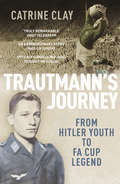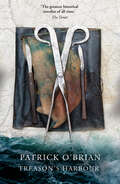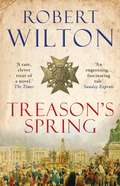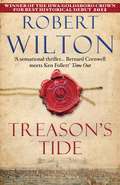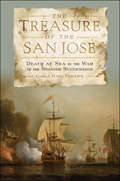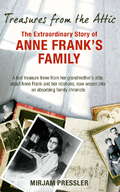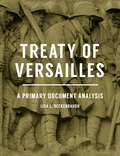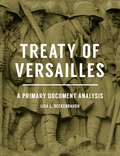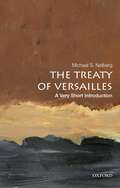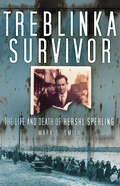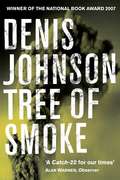- Table View
- List View
Trauma, Religion and Spirituality in Germany during the First World War
by Jason CrouthamelThis book explores the impact of violence on the religious beliefs of front soldiers and civilians in Germany during the First World War. The central argument is that religion was the main prism through which men and women in the Great War articulated and processed trauma. Inspired by trauma studies, the history of emotions, and the social and cultural history of religion, this book moves away from the history of clerical authorities and institutions at war and instead focuses on the history of religion and war 'from below.' Jason Crouthamel provides a fascinating exploration into the language and belief systems used by ordinary people to explain the inexplicable. From Judeo-Christian traditions to popular beliefs and 'superstitions,' German soldiers and civilians depended on a malleable psychological toolbox that included a hybrid of ideas stitched together using prewar concepts mixed with images or experiences derived from the surreal environment of modern combat. Perhaps most interestingly, studying the front experience exposes not only lived religion, but also how religious beliefs are invented. Front soldiers in particular constructed new, subjective spiritual and religious concepts based on encounters with industrialized weapons, the sacred experience of comradeship, and immersion in mass death, which profoundly altered their sense of self and the supernatural. More than just a coping mechanism, religious language and beliefs enabled victims, and perpetrators, of violence to narrate concepts of psychological renewal and rebirth. In the wake of defeat and revolution, religious concepts shaped by the war experience also became a cornerstone of visions for radical political movements, including the National Socialists, to transform a shattered and embittered German nation.Making use of letters between soldiers and civilians, diaries, memoirs and front newspapers, Trauma, Religion and Spirituality in Germany during the First World War offers a unique glimpse into the belief systems of men and women at a turning point in European history.
Traumatic Memories of the Second World War and After
by Peter Leese Jason CrouthamelThis collection investigates the social and cultural history of trauma to offer a comparative analysis of its individual, communal, and political effects in the twentieth century. Particular attention is given to witness testimony, to procedures of personal memory and collective commemoration, and to visual sources as they illuminate the changing historical nature of trauma. The essays draw on diverse methodologies, including oral history, and use varied sources such as literature, film and the broadcast media. The contributions discuss imaginative, communal and political responses, as well as the ways in which the later welfare of traumatized individuals is shaped by medical, military, and civilian institutions. Incorporating innovative methodologies and offering a thorough evaluation of current research, the book shows new directions in historical trauma studies.
Trautmann's Journey: From Hitler Youth to FA Cup Legend
by Catrine ClaySHORTLISTED FOR THE WILLIAM HILL SPORTS BOOK OF THE YEARHow did one man go from Nazi Youth indoctrination to English footballing icon?Bert Trautmann is a football legend. He is famed as the Manchester City goalkeeper who broke his neck in the 1956 FA Cup final and played on. But his early life was no less extraordinary. He grew up in Nazi Germany, where first he was indoctrinated by the Hitler Youth, before fighting in World War Two in France and on the Eastern Front. In 1945 he was captured and sent to a British POW camp where, for the first time, he understood that there could be a better way of life. He embraced England as his new home and before long became an English football hero. This is his story. 'A gripping story of an unlikely redemption through football' Sunday Times 'He was the best goalkeeper I ever played against. We always said, don't look into the goal when you're trying to score against Bert. Because if you do, he'll see your eyes and read your thoughts.' Bobby Charlton
A Traveller in War-Time: With An Essay On The American Contribution And The Democratic Idea (The World At War)
by Winston ChurchillA Traveller in War-Time is a non-fiction book by American author Winston Churchill recounting his travels in Europe during World War I. Released in July 1918 with the full title A Traveller in War-time with an Essay on the American Contribution and the Democratic Idea, the essay comprises about half of the book. It was Churchill's first non-fiction book.(Excerpt from Wikipedia)
Travellers in the Golden Realm: How Mughal India Connected England to the World
by Lubaaba Al-Azami'This is a remarkable book. It combines a spellbinding account of the first forgotten half of the English encounter with India with a fascinating history of the Mughal Empire' JOSEPHINE QUINN, author of How the World Made the West'A compelling, highly readable account of the earliest phase of English presence in India' NANDINI DAS, author of Courting IndiaWhen the first English travellers in India encountered an unimaginable superpower, their meetings would change the world.Before the East India Company and before the British Empire, England was a pariah state. Seeking better fortunes, 16th and 17th century merchants, pilgrims and outcasts ventured to the kingdom of the mighty Mughals, attempting to sell coarse woollen broadcloth along the silk roads; playing courtiers in the Mughal palaces in pursuit of love; or simply touring the sub-continent in search of an elephant to ride. Into this golden realm went Father Thomas Stephens, a Catholic fleeing his home; the merchant Ralph Fitch looking for jewels in the markets of Delhi; and John Mildenhall, an adventurer revelling in the highwire politics of the Mughal elite. It was a land ruled from the palatial towers by women - the formidable Empress Nur Jahan Begim, the enterprising Queen Mother Maryam al-Zamani, and the intrepid Princess Jahanara Begim. Their collision of worlds helped connect East and West, launching a tempestuous period of globalisation spanning from the Chinese opium trade to the slave trade in the Americas.Drawing on rich, original sources, Lubaaba Al-Azami traces the origins of a relationship between two nations - one outsider and one superpower - whose cultures remain inextricably linked to this day.
Travelling memories: Deutschsprachige Kinder- und Jugendliteratur über die Flucht während des Nationalsozialismus und aus der DDR (Studien zu Kinder- und Jugendliteratur und -medien #15)
by Larissa Carolin JagdschianAufgrund der anhaltenden Fluchtbewegungen fordert Aleida Assmann zur Umstrukturierung national ausgerichteter Erinnerungskulturen auf, damit Flüchtlinge mehr an Erinnerungsprozessen partizipieren können. Diese Forderung greift die Studie am Beispiel der Untersuchung der topografischen und erinnerungskulturellen Darstellungen der Flucht in der Kinder- und Jugendliteratur auf, indem ein Modell des Gedächtnisses der deutschsprachigen Kinder- und Jugendliteratur entwickelt wird. Im Vordergrund stehen zwei historische Phasen: die Flucht während des Nationalsozialismus (1933–1945) und die Flucht aus der Deutschen Demokratischen Republik (1957–1989). Mit der vergleichenden Untersuchung von Exilromanen, realistischen ost- und westdeutschen Kinder- und Jugendromanen nach 1945, DDR-Mädchenromanen, zeitgeschichtlichen und geschichtserzählenden Romanen von u. a. Lisa Tetzner (Die Kinder aus Nr. 67), Kurt Held (Giuseppe und Maria), Erika Mann (A Gang of Ten), Peter Abraham (Die Schüsse der Arche Noah oder die Irrtümer meines Freundes Wensloff), Judith Kerr (Als Hitler das rosa Kaninchen stahl), Lilo Hardel (Karlas große Reise), Brigitte Birnbaum (Reise in den August), Karin König (Ich fühl mich so fifty-fifty), Mirjam Pressler (Malka Mai) und Klaus Kordon (Krokodil im Nacken) wird erstmals das Spektrum der literarischen Gedächtniskonstruktionen von der Flucht während des Nationalsozialismus und aus der Deutschen Demokratischen Republik abgesteckt. Die Studie zeigt in der Verknüpfung von Gedächtnis- und Raumkonzepten, dass sich im Gedächtnis der deutschsprachigen Kinder- und Jugendliteratur die literarischen Gedächtniskonstruktionen über Flucht als „travelling memory“ (Erll 2011) ausgebildet haben. Damit trägt die Studie zur Theoriebildung literaturwissenschaftlicher Gedächtniskonzepte in der Kinder- und Jugendliteraturforschung bei.
Travesty: The Trial of Slobodan Milosevic and the Corruption of International Justice
by John LaughlandSlobodan Milosevic died in prison in 2006 during a four-year marathon trial at The Hague for war crimes. John Laughland was one of the last Western journalists to meet him. He followed the trial from the beginning and wrote extensively on it, challenging the legitimacy of the Yugoslav Tribunal and the hypocrisy of 'international justice' in the Guardian and the Spectator.*BR**BR*In this book Laughland gives a full account of the trial, which was the longest criminal trial in history. From the moment the indictment was issued at the height of NATO's attack on Yugoslavia to the day of Milosevic's mysterious death in custody. 'International justice' is supposed to hold war criminals to account but, as the trials of both Milosevic and Saddam Hussein show, the indictments are politically motivated and the judicial procedures are irredeemably corrupt. *BR**BR*Laughland argues that international justice is an impossible dream and that such show trials are little more than a propaganda exercise designed to distract attention from the war crimes committed by Western states.
Treading Softly: U.S. Marines in China, 1819-1949
by George B. ClarkFrom the mid-19th century to the early Cold War, the United States has a long history with China, and that interaction has not always been positive or productive. This brief history of foreign intervention in China, viewed through the experiences of the United States Marines, examines how the occupying powers dealt with a fellow sovereign nation. In many cases this involved the partition or outright absorption of Chinese territory through naked aggression. Clark contends that, considering the past two centuries, the Chinese have good reason to distrust all foreigners, and he urges the pursuit of a badly needed rapprochement.This is, however, also the story of the evolution of the Marine Corps as a separate service. Although an occupying force, the Marines did make considerable efforts to earn the friendship of the Chinese people. Always on the brink of extinction due to budgetary cuts and the enmity of the army and navy, the Marines managed to perform an onerous and difficult duty in a foreign land. With a resurgent China constantly testing the United States, a fellow Pacific Rim nation, every policymaker should be well aware of the often difficult history that we share and the mistakes that have been made in the past.
Treason: A Novel (The Major Brooke Grant Series #2)
by Newt Gingrich Pete EarleyMajor Brooke Grant must track down the double agent who is infiltrating the U.S. government in this international thriller from influential politician Newt Gingrich and Pulitzer Prize finalist Pete Earley.Brooke Grant has been waging war against terrorism since her parents were murdered during 9/11, keenly aware that violence transcends borders. But after a coordinated attack on the president at a Washington power broker's funeral, she realizes that the enemy is closer than she'd ever imagined, hiding in plain sight. The Falcon has gained a weapon no terrorist has ever wielded before: an American-born traitor burrowed inside the U.S. government itself. Major Grant's deadly chess match with the Falcon turns personal when he issues a fatwa against her and those she loves. Can she unmask the traitor and stop the Falcon's most skilled assassin sent to kill her before he strikes? Or will she fall victim to betrayal by a false friend in this gripping story of treachery, courage, and the patriotic fight against evil? In this realistic tale of modern-day treason, a nation fights for its life against an internal threat: a fanatical jihadist who uses liberty as a shield while trying to destroy the civilization created in its image. With decades of knowledge in national security and politics, only Newt Gingrich and Pete Earley could spin such a vivid mix of reality and fiction -- a page-turner that dares readers to guess where the line between the two is crossed.
Treason on the Airwaves: Three Allied Broadcasters on Axis Radio during World War II (Non-ser.)
by Judith KeeneThis work traces the extraordinary journeys of three World War II radio broadcasters in Germany and Japan whose wartime choices became treason in Britain, Australia, and the United States. John Amery, a member of a well-connected British family, joined Hitler's propagandists in Berlin. He was executed for treason by Britain after the war. Charles Cousens was a soldier in Japanese captivity when he was put to work on Radio Tokyo with a team of Allied POWs. Cousens was later tried as a traitor in Australia. Iva Toguri, better known as Tokyo Rose, was an American student visiting Japan when war broke out. She broadcast her English show on Radio Tokyo out of necessity rather than conviction. The United States jailed Toguri for treason. Through these powerful stories, this work not only sheds new light on the history of wartime radio broadcasting in Germany and Japan, but also examines the laws of treason in Britain, Australia, and the United States and the ways in which trials such as these helped shape modern-day treason trials. All three accounts provoke thoughtful questions as to the nature of justice—and the justice of retribution. This work traces the extraordinary journeys of three World War II radio broadcasters in Germany and Japan whose wartime choices became treason in Britain, Australia, and the United States.
Treason’s Harbour (Aubrey/Maturin Series #9)
by Patrick O’BrianPatrick O’Brian’s Aubrey-Maturin tales are widely acknowledged to be the greatest series of historical novels ever written. Now, for the first time, they are available in electronic book format, so a whole new generation of readers can be swept away on the adventure of a lifetime. This is the ninth book in the series.
Treason's Spring: A sweeping historical epic for fans of CJ Sansom (Archives of Tyranny #4)
by Robert WiltonFrom the winner of the Historical Writers' Association/Goldsboro Crown Award for Historical Debut Fiction.'A rare, clever treat of a novel.' Antonia Senior, The Times1792: the blood begins to drip from the guillotine. The French Revolution is entering its most violent phase, and threatens all Europe with chaos. In the age of the mob, no individual is safe. The spies of England, France and Prussia are fighting their own war for survival and supremacy. Somewhere in Paris is a hidden trove of secrets that will reveal the treacheries of a whole continent.At the height of the madness a stranger arrives in Paris, to meet a man who has disappeared. Unknown and untrusted, he finds himself the centre of all conspiracy. When the world is changing forever, what must one man become to survive?Treason's Spring is a thrilling and meticulous panorama of Paris in the Revolution whose revelations transform our understanding of an era.
Treason's Tide (Archives of Tyranny #1)
by Robert WiltonAn intense, imaginative and darkly atmospheric historical spy thriller - Patrick O'Brian meets John le Carré. (previously published as The Emperor's Gold)'A sparkling gem of a novel' - M C ScottJuly 1805: Napoleon's army masses across the Channel - Britain is within hours of invasion and defeat. Only one thing stands in the way - an obscure government bureau of murky origins and shadowy purpose: The Comptrollerate General for Scrutiny and Survey. And, rescued from a shipwreck, his past erased, Tom Roscarrock is their newest agent.In England, the man who recruited Roscarrock has disappeared, his agents are turning up dead, and reports of a secret French fleet are panicking the authorities. In France, a plan is underway to shatter the last of England's stability. Behind the clash of fleets and armies, there lies a secret world of intrigue, deception, treachery and violence - and Roscarrock is about to be thrown into it headfirst.
The Treasure of the San José: Death at Sea in the War of the Spanish Succession
by Carla Rahn PhillipsSunk in a British ambush in 1708, the Spanish galleon San José was rumored to have one of the richest cargos ever lost at sea. Though treasure hunters have searched for the wreck's legendary bounty, no one knows exactly how much went down with the ship or exactly where it sank. Here, Carla Rahn Phillips confronts the legend of lost treasure with documentary records of the San José's final voyage and suggests that the loss of silver and gold en route to Spain paled in comparison to the loss of the six hundred men who went down with the ship.Drawing from rich archival records, Phillips presents a biography of the ship and its crew. With vivid detail and meticulous scholarship, the author tells the stories of the officers, sailors, apprentices, and pages who manned the ship and explains the historical context in which the San José became prey to the British squadron. But the story does not end with the sinking of the San José. While Phillips addresses the persistent question of how much treasure was on board when the ship went down, she focuses on the human dimensions of the tragedy as well. She recovers the accounts of British naval officers involved in the battle, and examines the impact of the ship's loss on the Spanish government, the survivors, and the families of the men who perished. Original, comprehensive, and compelling, The Treasure of the San José separates popular myth from history and sheds light on the human lives associated with a "treasure" ship.
Treasures from the Attic: The Extraordinary Story Of Anne Frank's Family
by Mirjam PresslerThe Story of Anne Frank and her Family and her famous diaries told with the help of thousands of letters, documents and photographs recently discovered in an attic. Anne Frank wrote a diary from the age of 13 as she hid for over two years in the back of an Amsterdam warehouse escaping the horrors of Nazi occupation. An intimate record of tension and struggle, adolescence and confinement, anger and heartbreak, it is among the most enduring documents of the twentieth century, famed throughout the world. Since first publication in 1947, the diary has been read by tens of millions of people in many different translations. A bestseller in its 1952 and 1997 (definitive) editions it remains a beloved and deeply admired testament to the indestructible nature of the human spirit. Recently discovered letters, documents and photographs of Anne and her family including letters from her, her father’s letters from Auschwitz and his poignant descriptions of searching for his family after the war and his discovery of the dairies, have been made into a family saga by Mirjam Pressler, the editor of the definitive edition of the Diary. The book which reads like a novel, an epic, fateful, family saga, recounts the story of Anne’s family both before, during and after the war. It contrasts the normality of family life with the horrors of persecution, deportation and the concentration camps and through it we gain new insight into Anne and her iconic diary, one of those unique documents that portrays innocence and humanity, suffering and survival in the starkest and most moving terms.
The Treatment of the War Dead in Archaic Athens: An Ancestral Custom
by Cezary KucewiczExploring the representations of the war dead in early Greek mythology, particularly the Homeric poems and the Epic Cycle, alongside iconographic images on black-figure pottery and the evidence of funerary monuments adorning the graves of early Athenian elites, this book provides much-needed insight into the customs associated with the war dead in Archaic Athens. It is demonstrated that this period had remarkably little in common with the much-celebrated institutions of the Classical era, standing in fact much closer to the hierarchical ideals enshrined in the epics of Homer and early mythology. While the public burial of the war dead in Classical Athens has traditionally been a subject of much scholarly interest, and the origins of the procedures described by Thucydides as patrios nomos are still a matter of some debate, far less attention has been devoted to the Athenian war dead of the preceding era. This book aims to redress the imbalance in modern scholarship and put the spotlight on the Athenian war dead of the Archaic period. In addition, the book deepens our understanding of the processes which led to the establishment of first public burials and the Classical customs of patrios nomos, shedding significant light on the military, cultural and social history of Archaic Athens. Challenging previous assumptions and bringing new material to the table, the book proposes a number of new ways to investigate a period where many 'ancestral customs' were thought to have their roots.
The Treatment of the War Dead in Archaic Athens: An Ancestral Custom
by Cezary KucewiczExploring the representations of the war dead in early Greek mythology, particularly the Homeric poems and the Epic Cycle, alongside iconographic images on black-figure pottery and the evidence of funerary monuments adorning the graves of early Athenian elites, this book provides much-needed insight into the customs associated with the war dead in Archaic Athens. It is demonstrated that this period had remarkably little in common with the much-celebrated institutions of the Classical era, standing in fact much closer to the hierarchical ideals enshrined in the epics of Homer and early mythology. While the public burial of the war dead in Classical Athens has traditionally been a subject of much scholarly interest, and the origins of the procedures described by Thucydides as patrios nomos are still a matter of some debate, far less attention has been devoted to the Athenian war dead of the preceding era. This book aims to redress the imbalance in modern scholarship and put the spotlight on the Athenian war dead of the Archaic period. In addition, the book deepens our understanding of the processes which led to the establishment of first public burials and the Classical customs of patrios nomos, shedding significant light on the military, cultural and social history of Archaic Athens. Challenging previous assumptions and bringing new material to the table, the book proposes a number of new ways to investigate a period where many 'ancestral customs' were thought to have their roots.
Treaty of Versailles: A Primary Document Analysis
by Lisa L. BeckenbaughAn indispensable resource on the Treaty of Versailles, one of the most influential and controversial documents in history, this book explains how the treaty tried to solve the complex issues that emerged from the destruction of World War I.This carefully curated primary source collection includes roughly 60 documents related to the signing of the Treaty of Versailles. By collecting all of the most significant documents in one volume, it allows readers to hear the original arguments surrounding the treaty and to explore the voices of the people involved at the Paris Peace Conference. Moreover, it allows readers to engage with the documents so as to better understand the complex motivations and issues coming out of World War I and highlights the differences between the victors and identifies the problems many countries had with the treaty before it was even signed.The documents are organized in chronological order, providing a blueprint to help students to understand all of the significant events that led to the treaty, as well as the vast repercussions of the treaty itself. In addition to the Treaty of Versailles itself, documents include such significant primary sources as the Sykes-Picot Agreement, the Balfour Declaration, the Treaty of Brest-Litovsk, President Woodrow Wilson's Fourteen Points, and Germany's response to the treaty.
Treaty of Versailles: A Primary Document Analysis
by Lisa L. BeckenbaughAn indispensable resource on the Treaty of Versailles, one of the most influential and controversial documents in history, this book explains how the treaty tried to solve the complex issues that emerged from the destruction of World War I.This carefully curated primary source collection includes roughly 60 documents related to the signing of the Treaty of Versailles. By collecting all of the most significant documents in one volume, it allows readers to hear the original arguments surrounding the treaty and to explore the voices of the people involved at the Paris Peace Conference. Moreover, it allows readers to engage with the documents so as to better understand the complex motivations and issues coming out of World War I and highlights the differences between the victors and identifies the problems many countries had with the treaty before it was even signed.The documents are organized in chronological order, providing a blueprint to help students to understand all of the significant events that led to the treaty, as well as the vast repercussions of the treaty itself. In addition to the Treaty of Versailles itself, documents include such significant primary sources as the Sykes-Picot Agreement, the Balfour Declaration, the Treaty of Brest-Litovsk, President Woodrow Wilson's Fourteen Points, and Germany's response to the treaty.
The Treaty of Versailles: A Very Short Introduction (Very Short Introductions)
by Michael S. NeibergSigned on June 28, 1919 between Germany and the principal Allied powers, the Treaty of Versailles formally ended World War I. Problematic from the very beginning, even its contemporaries saw the treaty as a mediocre compromise, creating a precarious order in Europe and abroad and destined to fall short of ensuring lasting peace. At the time, observers read the treaty through competing lenses: a desire for peace after five years of disastrous war, demands for vengeance against Germany, the uncertain future of colonialism, and, most alarmingly, the emerging threat of Bolshevism. A century after its signing, we can look back at how those developments evolved through the twentieth century, evaluating the treaty and its consequences with unprecedented depth of perspective. The author of several award-winning books, Michael S. Neiberg provides a lucid and authoritative account of the Treaty of Versailles, explaining the enormous challenges facing those who tried to put the world back together after the global destruction of the World War I. Rather than assessing winners and losers, this compelling book analyzes the many subtle factors that influenced the treaty and the dominant, at times ambiguous role of the "Big Four" leaders: Woodrow Wilson of the United States, David Lloyd George of Great Britain, Vittorio Emanuele Orlando of Italy, and Georges Clémenceau of France. The Treaty of Versailles was not solely responsible for the catastrophic war that crippled Europe and the world just two decades later, but it played a critical role. As Neiberg reminds us, to understand decolonization, World War II, the Cold War, and even the complex world we inhabit today, there is no better place to begin than with World War I and the treaty that tried, and perhaps failed, to end it. ABOUT THE SERIES: The Very Short Introductions series from Oxford University Press contains hundreds of titles in almost every subject area. These pocket-sized books are the perfect way to get ahead in a new subject quickly. Our expert authors combine facts, analysis, perspective, new ideas, and enthusiasm to make interesting and challenging topics highly readable.
The Treaty of Versailles: A Very Short Introduction (Very Short Introductions)
by Michael S. NeibergSigned on June 28, 1919 between Germany and the principal Allied powers, the Treaty of Versailles formally ended World War I. Problematic from the very beginning, even its contemporaries saw the treaty as a mediocre compromise, creating a precarious order in Europe and abroad and destined to fall short of ensuring lasting peace. At the time, observers read the treaty through competing lenses: a desire for peace after five years of disastrous war, demands for vengeance against Germany, the uncertain future of colonialism, and, most alarmingly, the emerging threat of Bolshevism. A century after its signing, we can look back at how those developments evolved through the twentieth century, evaluating the treaty and its consequences with unprecedented depth of perspective. The author of several award-winning books, Michael S. Neiberg provides a lucid and authoritative account of the Treaty of Versailles, explaining the enormous challenges facing those who tried to put the world back together after the global destruction of the World War I. Rather than assessing winners and losers, this compelling book analyzes the many subtle factors that influenced the treaty and the dominant, at times ambiguous role of the "Big Four" leaders: Woodrow Wilson of the United States, David Lloyd George of Great Britain, Vittorio Emanuele Orlando of Italy, and Georges Clémenceau of France. The Treaty of Versailles was not solely responsible for the catastrophic war that crippled Europe and the world just two decades later, but it played a critical role. As Neiberg reminds us, to understand decolonization, World War II, the Cold War, and even the complex world we inhabit today, there is no better place to begin than with World War I and the treaty that tried, and perhaps failed, to end it. ABOUT THE SERIES: The Very Short Introductions series from Oxford University Press contains hundreds of titles in almost every subject area. These pocket-sized books are the perfect way to get ahead in a new subject quickly. Our expert authors combine facts, analysis, perspective, new ideas, and enthusiasm to make interesting and challenging topics highly readable.
Treblinka Survivor: The Life and Death of Hershl Sperling (History Press Ser.)
by Mark S SmithMore than 800,000 people entered Treblinka, and fewer than seventy came out. Hershl Sperling was one of them. He escaped. Why then, fifty years later, did he jump to his death from a bridge in Scotland? This book traces the life of a man who survived five concentration camps, and what he had to do to achieve this.
Tree of Smoke (Thorndike Basic Ser.)
by Denis JohnsonTree of Smoke – the name given to a ‘psy op’ that might or might not be hypothetical and might or might not be officially sanctioned – is Denis Johnson’s most gripping, visionary and ambitious work to date. Set in south-east Asia and the US, and spanning two decades, it ostensibly tells the story of Skip Sands, a CIA spy who may or may not be engaged in psychological operations against the Viet Cong -- but also takes the reader on a surreal yet vivid journey, dipping in and out of characters’ lives to reveal fundamental truths at the heart of the human condition. ‘A Catch-22 for our times’ Alan Warner, Books of the Year, Observer 'The God I want to believe in has a voice and a sense of humour like Denis Johnson's' Jonathan Franzen ‘An epic of drenched sensuality and absurdly chewable dialogue, as though Don DeLillo and Joseph Heller had collaborated on a Vietnam war novel’ Steven Poole, Books of the Year, New Statesman
Trench: A History of Trench Warfare on the Western Front
by Stephen BullEven now, 100 years on from the conflict, the image of trenches stretching across Western Europe – packed with young men clinging to life in horrendous conditions – remains a powerful reminder of one of the darkest moments in human history. In this excellent study of trench warfare on the Western Front, expert Dr Stephen Bull reveals the experience of life in the trenches, from length of service and coping with death and disease, to the uniforms and equipment given to soldiers on both sides of the conflict. He reveals how the trenches were constructed, the weaponry which was developed specifically for this new form of warfare, the tactics employed in mass attacks and the increasingly adept defensive methods designed to hold ground at all cost. Packed with photographs, illustrations, annotated trench maps, documents and first-hand accounts, this compelling narrative provides a richly detailed account of World War I, providing a soldier's-eye-view of life in the ominous trenches that scarred the land.
Trench: A History of Trench Warfare on the Western Front (General Military Ser.)
by Stephen BullEven now, 100 years on from the conflict, the image of trenches stretching across Western Europe – packed with young men clinging to life in horrendous conditions – remains a powerful reminder of one of the darkest moments in human history. In this excellent study of trench warfare on the Western Front, expert Dr Stephen Bull reveals the experience of life in the trenches, from length of service and coping with death and disease, to the uniforms and equipment given to soldiers on both sides of the conflict. He reveals how the trenches were constructed, the weaponry which was developed specifically for this new form of warfare, the tactics employed in mass attacks and the increasingly adept defensive methods designed to hold ground at all cost. Packed with photographs, illustrations, annotated trench maps, documents and first-hand accounts, this compelling narrative provides a richly detailed account of World War I, providing a soldier's-eye-view of life in the ominous trenches that scarred the land.


